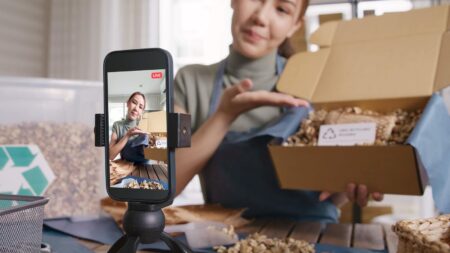Food is an exciting and challenging industry for entrepreneurs. Many have successfully transformed staple foods into brilliant new brands by focusing on quality, innovation, and unique branding, as evidenced through names such as Kirsty’s, New Covent Garden Soup and Mike’s Hot Honey.
Creating an exciting new brand from an everyday food item relies on two key factors: a brand’s willingness to challenge conventional norms and its ability to connect with its target consumers on an emotional level. These factors require brands to have a strong vision, well-defined values, and a clear personality, as Julie Sternberg, managing director, food and beverage at Hunter PR, explains.
She says: “When it comes to staple food products, purchase behavior is rooted in muscle memory and consumers tend to reflexively buy brands that they grew up with or that their parents stocked at home.
“However, winning brands in this industry are challenging conventional norms by offering an elevated taste experience that answers consumer desire for global flavors, provide an alternative for those with dietary needs or considerations, or give consumers a customized experience where there was never one to be found.”
Fishing for success
It was during the dark days of Covid lockdown that Becca Millstein and her roommate found themselves eating copious amounts of tinned fish. “It was consistent with our quarantine lifestyle, eating, and shopping habits, limiting grocery visits while looking for food products that were shelf-stable but also satiating and nutritious,” says Millstein. “It turned out that only tinned fish and canned beans fit the bill.”
She also discovered a glaring gap in the canned food space in the U.S. Despite the rich culinary cultures surrounding tinned fish around the world, the space remained barren and stale in U.S. grocery stores.
This presented her with an opportunity to innovate in the space and put sustainability at the forefront and led to the launch of Los Angeles-based food company Fishwife, a name that pays homage to the wives of fishermen who historically sold their husbands’ catches at markets. The aim was to make ethically sourced, premium, tasty, tinned seafood a feature of every kitchen cupboard.
CEO Millstein, a former marketing professional who specialized in brand partnerships, and her cofounder Caroline Goldfarb, began by mapping out the visual brand identity to transform what was essentially a staple food product into something special that stood out from the competition.
She says: “The canned fish aisle was filled with products that adhered to one overarching visual theme; the colors were blue, white and green, and the graphic elements were limited to the same main character, a fish. For the Fishwife brand to stand out, it had to be positioned it in a near opposite way to the existing category, and that started with the visuals.
“Where there was previously only white, blue, and green, there was now bright pink, green, red, and cobalt. Where there was a realistic interpretation of a fish, there was an adorably irreverent fishwife smoking a pipe, a fanciful depiction of wherever the fish at hand was sourced.”
Brand storytelling
Beyond the physical impact, winning brands must also find novel ways to connect with their target audience on an emotional level. Giving consumers an authentic, memorable, and novel experience that shows how the brand understands the consumer on a deeper level forges a connection that can’t be bought.
“Brand storytelling is incredibly important for forging an emotional connection with consumers,” says Sternberg. “Thanks to the Food Network, The Travel Channel, and influencer marketing, etc., consumers have a heightened desire to understand where their food comes from and hear the story behind how it is produced and sold.
“Going beyond traditional advertising, brands should be working with media known for telling these stories to create long and short-form digital content, partnering with influencers to create content that demonstrates the brands’ role in their lives.”
For her Fishwife marketing strategy, Millstein chose a communication method and channel previously unexplored in the canned fish category: social media as the method and direct-to-consumer (D2C) as the channel.
She says: “My goal was to create the first truly beloved tinned seafood brand and to achieve that, I focused on building direct and meaningful relationships with our customers and community; something these two channels naturally support.”
Today, Fishwife products are sold in retail and D2C and shipped nationwide. This year saw the launch of The Fishwife Cookbook and the development of three new tinned fish SKUs. “We’re also developing our first ever CPG (consumer packed goods) collaborative products in which Fishwife is used as an ingredient,” says Millstein.
A new generation of American cheese
Disillusioned with the old-school approach to traditional American cheese, longtime friends Alan Leavitt and Eric Greenspan set out to create a cleaner, tastier alternative and created New School American.
CEO Leavitt began his career as a corporate lawyer. Prior to launching New School, he had been leading the investment effort of a family office focused on early-stage consumer companies. It was in this capacity that he began attending trade shows like Expo West and Fancy Food Show, and developed a greater interest in the food.
“I’d just spent a couple of years as an investor, seeing countless new products in categories like popcorn, jerky, cold brew coffee, and plant-based meat,” he says. “And here was this pasteurized processed American cheese category that represents billions of dollars of sales in retail and foodservice and yet there were no challenger brands seeking to meet the modern consumer’s needs.”
His cofounder and head of culinary Greenspan is a professional chef and a pioneer of the ghost kitchen world, creating a multi-concept delivery-only business from an early cloud kitchen space. He is also credited with coming up with the idea for New School. Leavitt explains: “We were having dinner with our families, and he rattled off several food ideas, most of which I didn’t find compelling. But when he mentioned artisanal American cheese, I was immediately excited.”
Focus on user experience
The pair began working on the idea for New School in 2017 and spent the first two years experimenting and testing to find the right recipe. After a temporary pause during the pandemic the business was launched in September 2022. Before starting the product innovation process, they researched to understand what consumers and chefs liked and didn’t like about American cheese in terms of taste preferences, performance requirements, and perceptions of various ingredients
Once they had finalized their recipe and production processes, they focused on developing a brand identity and strategy based on their own strengths and weaknesses, the competitive landscape, and an understanding of the customer.
“We differentiate ourselves through the cheese’s taste, mouthfeel, and performance, or ‘meltability’,” says Leavitt. “We are fortunate to have so many esteemed chefs, influencers, and restaurants use New School and call it out by name on the menu. This leads to quality by association and chef validation.”
New School is available in several small, independent specialty stores, cheese and butcher shops. The plan is to continue to expand via the food service channel, driving trial and awareness through their chef and restaurant partners, while carefully and strategically entering retail. Leavitt adds: “Our goal is to be available globally in retail and food service, giving consumers a premium option in this large category.”
Evolving brilliant new brands
Sustaining success and relevancy over time is no easy task for brilliant new brands. It requires constant reinvention and evolving not only with the core consumer base but also turning new consumers to brand fans.
“The most successful entrepreneurs understand that you must continually invest in your brand and keep innovation at the forefront while remaining true to brand values,” says Sternberg. “Brands that have gone from challenger to established market leader, such as Seedlip, Liquid Death, and Kodiak, challenge consumer packaged goods norms but stay true to their core values. These successful brands have a distinct point of view in the marketplace, but you can also see them evolving over time and not leaning on what worked yesterday.”
Read the full article here











